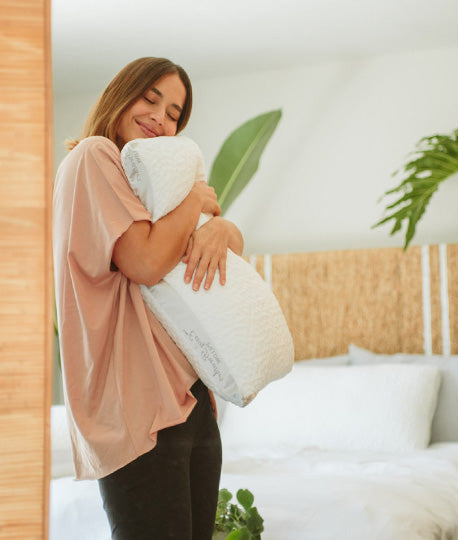The Best Bedding Material: A Guide to Choosing the Perfect Sheets
by Christian Alexander - CEO
When it comes to getting a good night’s sleep, choosing the right bedding material is crucial.
Whether you’re upgrading your bedroom or simply replacing worn-out sheets, understanding the differences between popular materials can help you make the best choice for your comfort, skin, and sleep quality. Let's dive into the top bedding materials and highlight their unique benefits.
1. Cotton: The Classic Choice
Cotton is one of the most popular bedding materials due to its softness, breathability, and durability. It’s versatile, easy to care for, and perfect for all seasons. Here are a few different types of cotton that stand out:
- Egyptian Cotton: Known for its luxurious feel, Egyptian cotton is incredibly soft, strong, and durable. Its long fibers create a smooth fabric that resists pilling.
- Pima Cotton: Similar to Egyptian cotton, Pima cotton is also long-staple cotton known for its softness and durability. It’s often a more affordable alternative.
- Organic Cotton: For eco-conscious sleepers, organic cotton is grown without harmful pesticides and chemicals, making it a great sustainable option.
Pros: Soft, breathable, durable, and widely available.
Cons: Quality varies, and high-end options can be expensive.
2. Linen: Perfect for Warm Weather
Linen sheets are a favorite for those who prefer a natural, breathable material that stays cool in warm climates. Linen is made from flax fibers, which give it a unique texture and durability.
Linen sheets are highly breathable and moisture-wicking, making them ideal for hot sleepers or summer bedding. Though linen can feel stiff at first, it softens over time with repeated washing.
Pros: Exceptionally breathable, moisture-wicking, and long-lasting.
Cons: Can feel rough at first, wrinkles easily.
3. Bamboo: Sustainable and Soft
Bamboo bedding has grown in popularity for its eco-friendliness, soft feel, and cooling properties. Bamboo sheets are known for being incredibly silky, with a texture often compared to high-thread-count cotton or silk.
Bamboo is a sustainable crop, and when processed into fabric, it creates a breathable, moisture-wicking, and hypoallergenic material, ideal for those with sensitive skin or allergies.
Pros: Eco-friendly, soft, cooling, and hypoallergenic.
Cons: Quality can vary, and some types are chemically processed.
4. Silk: The Ultimate Luxury
For those who want to treat themselves to the most luxurious bedding, silk is the go-to material. Silk sheets feel incredibly soft and smooth against the skin, and they’re naturally hypoallergenic.
Silk bedding is also known for being temperature-regulating, meaning it can keep you cool in summer and warm in winter. However, silk requires special care, such as hand washing or dry cleaning, and tends to be more expensive.
Pros: Luxurious, hypoallergenic, and temperature-regulating.
Cons: Expensive and requires delicate care.
5. Microfiber: Budget-Friendly and Soft
Microfiber sheets are made from synthetic fibers, typically polyester, and are known for their affordability, softness, and wrinkle resistance. While not as breathable as natural fibers like cotton or linen, microfiber can still provide a cozy, warm sleeping experience, particularly in cooler climates.
Pros: Soft, affordable, and low-maintenance.
Cons: Less breathable, can trap heat, and may pill over time.
6. Tencel: Eco-Friendly and Gentle
Tencel, also known as lyocell, is an eco-friendly fabric made from wood pulp, typically sourced from eucalyptus trees. Tencel sheets are silky, breathable, and moisture-wicking, making them ideal for hot sleepers.
Additionally, Tencel is gentle on the skin and hypoallergenic, which makes it a great choice for people with allergies or skin sensitivities.
Pros: Sustainable, soft, breathable, and hypoallergenic.
Cons: Can be expensive and requires gentle care.
Choosing the Best Material for You
When deciding which bedding material is best for you, consider your specific needs and preferences:
- For hot sleepers: Linen, bamboo, or Tencel are excellent choices for staying cool and comfortable.
- For luxury lovers: Egyptian cotton or silk will provide that smooth, opulent feel.
- For eco-conscious consumers: Bamboo, organic cotton, and Tencel are sustainable, eco-friendly options.
- For budget shoppers: Microfiber and standard cotton sheets offer comfort without breaking the bank.
Final Thoughts
The best bedding material ultimately depends on your sleeping habits, skin sensitivities, and preferences. Whether you want the silky luxury of silk or the eco-friendliness of bamboo, there’s a perfect option out there for you. Investing in high-quality bedding can significantly improve your sleep quality and help you wake up refreshed and ready to take on the day.
Happy sleeping!




